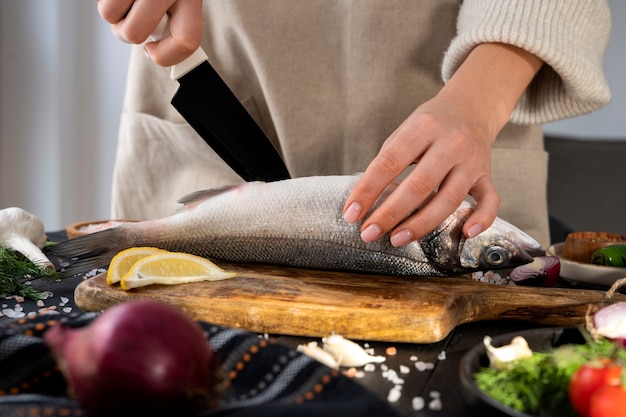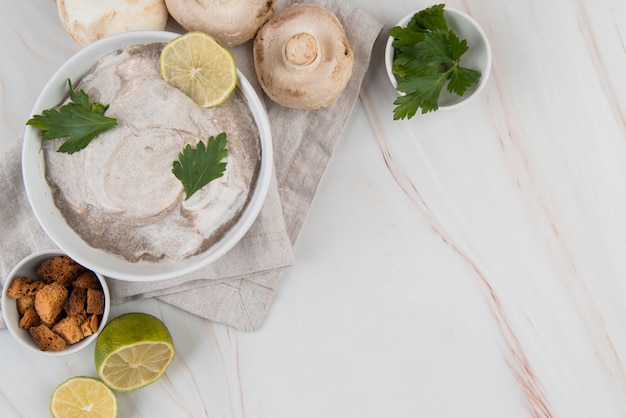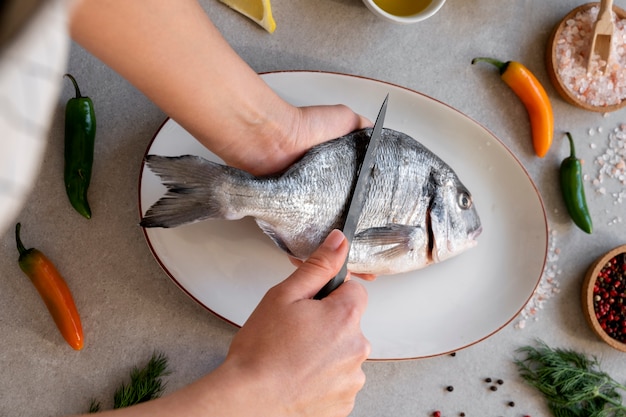As a senior article editor, I've tasted my fair share of culinary delights, but there's something about halibut that always gets me excited. It's a versatile fish with a delicate flavour and firm texture that holds up beautifully to various cooking methods. Whether you're a seasoned chef or a kitchen novice, halibut is a great choice for a satisfying meal. Today, I'm sharing some of my favourite halibut recipes, along with tips and tricks I've learned over the years. Get ready to unlock the delicious potential of this amazing fish!
(Part 1) Getting to Know Halibut

Before diving into the recipes, let's talk about halibut itself. It's a flatfish found in the North Atlantic and Pacific oceans, and it's a real heavyweight, often reaching sizes of up to 8 feet long! The meat is white and flaky, with a mild, almost sweet taste. It's naturally low in fat and a great source of protein and omega-3 fatty acids, making it a healthy and delicious choice for any meal.
Choosing the Right Halibut
The quality of your halibut will significantly impact the final dish. Here's what to look for when choosing fresh halibut:
- Freshness: The fish should smell fresh, not fishy. The flesh should be firm to the touch and spring back when pressed. If it feels mushy or has a strong fishy odour, it's best to avoid it.
- Colour: Halibut should have a bright, white flesh with no discoloration. Any brown or grey patches indicate that the fish is not fresh.
- Eyes: The eyes should be clear and black, not cloudy or sunken. This is a good indicator of freshness.
If you're buying frozen halibut, make sure it's been flash-frozen to preserve its flavour and texture. Look for packages that have been frozen quickly and stored at a consistently low temperature.
(Part 2) Simple and Delicious Halibut Recipes

Now for the fun part – cooking the halibut! These recipes are easy to follow and perfect for weeknight dinners or special occasions. They showcase the versatility of halibut and allow you to taste its natural deliciousness without being overshadowed by complex ingredients.
1. Pan-Seared Halibut with Lemon and Herbs
This recipe is a classic for a reason – it's quick, flavourful, and incredibly satisfying. The key to success is a good quality pan and a hot surface to sear the fish quickly, creating a crispy exterior and tender interior.
Ingredients:
- 1 pound halibut fillet, skin on or off
- 1 tablespoon olive oil
- Salt and freshly ground black pepper to taste
- 1 tablespoon chopped fresh parsley
- 1 tablespoon chopped fresh dill
- 1 lemon, cut into wedges
Instructions:
- Pat the halibut dry with paper towels. This will ensure a crisp sear and prevent the fish from steaming in the pan.
- Heat the olive oil in a large skillet over medium-high heat. Make sure the pan is piping hot before adding the fish.
- Season the halibut generously with salt and pepper. This step is crucial for flavour development.
- Add the halibut to the hot skillet and cook for 3-4 minutes per side, or until golden brown and cooked through. Be careful not to overcook the fish, as it can become dry and tough.
- Garnish with parsley, dill, and lemon wedges. The fresh herbs and citrus zest add a vibrant burst of flavour and aroma. Serve immediately.
2. Baked Halibut with Roasted Vegetables
This recipe is a one-pan wonder that's perfect for a fuss-free dinner. The halibut and vegetables are roasted together, resulting in a delicious, flavourful meal. The oven does all the work, allowing you to enjoy a healthy and satisfying dinner with minimal effort.
Ingredients:
- 1 pound halibut fillet, skin on or off
- 1 tablespoon olive oil
- Salt and freshly ground black pepper to taste
- 1 cup broccoli florets
- 1 cup Brussels sprouts, halved
- 1/2 cup cherry tomatoes
- 1/4 cup red onion, sliced
- 1 clove garlic, minced
- 2 tablespoons fresh thyme leaves
Instructions:
- Preheat the oven to 400°F (200°C). This ensures that the vegetables roast evenly and the halibut cooks through without overcooking.
- Toss the broccoli, Brussels sprouts, tomatoes, onion, garlic, and thyme in a large bowl with olive oil, salt, and pepper. This step coats the vegetables evenly with flavour and helps them to roast beautifully.
- Spread the vegetables in a single layer on a baking sheet. This allows the vegetables to cook evenly and prevents them from steaming.
- Place the halibut fillet on top of the vegetables. The halibut will cook in the juices of the roasting vegetables, resulting in a delicious and tender dish.
- Roast for 15-20 minutes, or until the halibut is cooked through and the vegetables are tender. Check the halibut with a fork to ensure it flakes easily.
3. Grilled Halibut with Mango Salsa
This recipe is perfect for warm summer evenings. The sweet and tangy mango salsa complements the delicate flavour of the grilled halibut perfectly. The combination of grilled fish and tropical salsa is a delightful fusion of flavours and textures.
Ingredients:
- 1 pound halibut fillet, skin on or off
- 1 tablespoon olive oil
- Salt and freshly ground black pepper to taste
- 1 ripe mango, diced
- 1/2 red onion, finely chopped
- 1/4 cup chopped fresh cilantro
- 1 tablespoon lime juice
- 1/2 teaspoon chili powder
Instructions:
- Preheat the grill to medium heat. Ensure the grill grates are clean and lightly oiled to prevent sticking.
- Brush the halibut fillet with olive oil and season with salt and pepper. This step adds moisture and flavour to the fish.
- Grill for 4-5 minutes per side, or until cooked through. Use a fish spatula to carefully flip the halibut to avoid breaking it.
- While the halibut is grilling, prepare the mango salsa. Combine the mango, red onion, cilantro, lime juice, and chili powder in a bowl. Mix gently to avoid bruising the mango.
- Serve the grilled halibut topped with mango salsa. The vibrant salsa adds a burst of sweetness, tanginess, and heat to the delicate halibut.
(Part 3) Beyond the Basics: Taking Halibut Recipes to the Next Level

While the simple recipes above are fantastic, there's always room for experimentation. Here are some ways to elevate your halibut game and explore its full culinary potential.
1. Embrace Global Flavours
Halibut is a blank canvas for culinary creativity. Experiment with bold, exotic flavours from around the world to create truly unique and exciting dishes.
- Asian Inspiration: Marinate the halibut in a mixture of soy sauce, ginger, and garlic, then pan-sear it until crispy. Serve with a side of rice and stir-fried vegetables for a delicious Asian-inspired meal. The combination of salty soy sauce, aromatic ginger, and pungent garlic creates a flavourful marinade that complements the delicate halibut beautifully.
- Mediterranean Flair: Combine halibut with cherry tomatoes, Kalamata olives, capers, and fresh oregano. Roast in the oven with a drizzle of olive oil for a flavourful Mediterranean feast. The salty olives, briny capers, and fragrant oregano create a delicious contrast to the mild halibut.
- South American Spice: Add a touch of heat to your halibut with a sprinkle of chili powder, cumin, and paprika. Serve with a side of black beans and rice for a vibrant South American-inspired meal. The combination of spices adds a smoky depth and a touch of heat to the halibut.
2. Master the Art of Marinating
Marinating halibut before cooking infuses it with flavour and tenderizes the meat. The marinade adds a layer of depth and complexity to the dish, making it even more enjoyable.
- Citrus Burst: Combine lemon juice, orange zest, olive oil, garlic, and herbs like thyme and rosemary for a bright and refreshing marinade. The citrus flavours add a touch of brightness and acidity to the halibut, while the herbs provide a complex and aromatic depth.
- Sweet and Spicy: Whisk together honey, soy sauce, ginger, garlic, and a touch of chili for a sweet and spicy marinade with a kick. The combination of sweet honey, salty soy sauce, and spicy chili creates a balanced and addictive marinade that complements the halibut perfectly.
- Garlic and Herb: Use a blend of fresh herbs like parsley, dill, tarragon, and garlic for a classic, aromatic marinade. The fresh herbs add a bright and fragrant aroma to the halibut, while the garlic adds a savory depth.
3. Play with Textures and Garnishes
The right garnish can take a dish from good to great. Experiment with different textures and colours to create a visually appealing and delicious meal.
- crispy skin: If you're cooking halibut with the skin on, try pan-searing it for a crispy, flavourful skin. The crispy skin adds a satisfying crunch and a burst of flavour to the dish.
- Fresh Herbs: Garnish your halibut with chopped fresh herbs like parsley, dill, chives, or basil for a bright, aromatic touch. The fresh herbs add a vibrant colour and a fragrant aroma to the dish.
- Citrus Zest: A sprinkle of lemon, orange, or lime zest adds a burst of citrus flavour and a beautiful pop of colour. The citrus zest adds a bright and refreshing touch to the halibut.
- Roasted Nuts: Toasted almonds, pecans, or walnuts provide a satisfying crunch and a nutty flavour. The roasted nuts add a textural contrast and a nutty depth to the dish.
(Part 4) Cooking Halibut to Perfection
One of the most common questions I get is "How do I cook halibut without overcooking it?" Overcooked halibut becomes dry and tough, so it's crucial to get the timing right. Here's what you need to know:
1. The Importance of Doneness
Halibut is cooked through when it reaches an internal temperature of 145°F (63°C). The flesh should be opaque and flake easily with a fork. If the fish is still translucent, it needs to be cooked a bit longer.
2. Cooking Methods and Timing
- Pan-Searing: Cook halibut for 3-4 minutes per side over medium-high heat. Use a good quality pan that heats evenly to ensure a crisp sear and tender interior.
- Baking: Roast halibut at 400°F (200°C) for 15-20 minutes, or until cooked through. Place the halibut on a baking sheet lined with parchment paper for easy cleanup.
- Grilling: Grill halibut for 4-5 minutes per side over medium heat. Use a fish spatula to carefully flip the halibut to avoid breaking it.
- Broiling: Broil halibut for 4-6 minutes, or until cooked through. Place the halibut on a baking sheet lined with parchment paper and broil under the highest setting. Keep a close eye on the fish to prevent it from burning.
Remember, cooking times can vary depending on the thickness of your halibut. If you're unsure, it's always better to err on the side of undercooking. You can always cook it for a bit longer if needed. Use a meat thermometer to check the internal temperature for the most accurate results.
(Part 5) side dishes that Complement Halibut
The beauty of halibut is that it pairs well with a wide range of side dishes. Here are some of my favourites, each offering a different flavour profile and texture to complement the delicate halibut.
- Roasted Vegetables: Roasted vegetables like asparagus, broccoli, Brussels sprouts, and carrots bring a vibrant colour and earthy flavour to the plate. The roasting process enhances the natural sweetness of the vegetables, creating a delicious contrast to the mild halibut.
- Green Salads: A simple green salad with a light vinaigrette provides a refreshing counterpoint to the richness of the halibut. The crispness of the salad adds a textural contrast, while the light vinaigrette balances the richness of the fish.
- orzo pasta Salad: A Mediterranean-inspired orzo pasta salad with tomatoes, olives, and feta cheese adds a touch of tanginess to the meal. The tanginess of the olives and feta cheese cuts through the richness of the halibut, creating a well-balanced dish.
- wild rice: The nutty flavour of wild rice complements the delicate flavour of halibut beautifully. The nutty flavour of the wild rice adds a complex dimension to the dish, creating a harmonious blend of flavours.
- mashed potatoes: For a comforting side dish, mashed potatoes are always a classic pairing. The creamy texture of the mashed potatoes provides a satisfying contrast to the flaky texture of the halibut.
(Part 6) The Versatility of Halibut
One of the things I love about halibut is its versatility. It's perfect for everything from simple weeknight meals to elegant dinners.
1. Everyday Meals
Halibut is an excellent choice for busy weeknights. It cooks quickly and can be paired with simple side dishes like roasted vegetables or a salad. The ease of preparation and the versatility of flavour pairings make it an ideal choice for busy weeknights.
2. Special Occasions
Halibut is also a great choice for special occasions. You can grill it, bake it, or pan-sear it, and serve it with elegant side dishes like mashed potatoes or risotto. The delicate flavour and elegant presentation make it perfect for impressing guests.
3. Leftovers
Leftover halibut can be used in a variety of ways. You can add it to salads, sandwiches, or even pasta dishes. This versatility ensures that you can enjoy halibut in multiple ways, reducing food waste.
(Part 7) Halibut Storage and Handling
Proper storage and handling are essential for keeping your halibut fresh and safe to eat. Here's what you need to know:
1. Fresh Halibut
Fresh halibut should be stored in the refrigerator for up to 2 days. Wrap it tightly in plastic wrap or aluminum foil, and place it on a plate to catch any drips. Storing halibut properly helps maintain its freshness and flavour.
2. Frozen Halibut
Frozen halibut can be stored in the freezer for up to 3 months. Wrap it tightly in plastic wrap or aluminum foil, and then place it in a freezer-safe bag. Make sure to remove as much air as possible from the bag to prevent freezer burn.
3. Thawing Halibut
To thaw frozen halibut, transfer it from the freezer to the refrigerator and let it thaw overnight. You can also thaw it in cold water, but make sure the water is constantly running to ensure the halibut doesn't sit in warm water. Avoid thawing halibut at room temperature, as this can increase the risk of bacteria growth.
(Part 8) Frequently Asked Questions (FAQs)
Here are some of the most common questions I get about halibut, along with detailed answers to help you make informed choices:
1. Is halibut sustainable?
Yes, halibut is a sustainable fish when sourced from well-managed fisheries. Look for labels like the Marine Stewardship Council (MSC) to ensure you're buying sustainably-caught halibut. Choosing sustainably-caught fish helps protect our oceans and ensures that future generations can enjoy this delicious fish.
2. How can I tell if halibut is cooked through?
Halibut is cooked through when it reaches an internal temperature of 145°F (63°C). The flesh should be opaque and flake easily with a fork. If the fish is still translucent or feels firm to the touch, it needs to be cooked a bit longer.
3. Can I eat halibut skin?
Yes, halibut skin is edible and can be quite delicious when cooked properly. Try pan-searing it for a crispy, flavourful skin. The skin adds a satisfying crunch and a unique flavour to the dish.
4. What are some healthy ways to cook halibut?
Halibut is a naturally low-fat fish, so it's already a healthy choice. To keep it healthy, choose cooking methods like baking, grilling, or pan-searing that don't require added fat. Avoid deep-frying, as this adds excess fat and calories.
5. What other fish are similar to halibut?
If you're looking for other white fish that are similar to halibut, try cod, haddock, or mahi-mahi. These fish have a similar texture and mild flavour, making them good alternatives. Each fish has its own unique characteristics, so experiment with different options to find your favourite.
(Part 9) A Final Word on Halibut
I truly believe halibut is one of the most versatile and delicious fish out there. It's a healthy, flavourful option that can be enjoyed in a variety of ways. Whether you're a seasoned chef or a kitchen novice, I encourage you to give halibut a try. You won't be disappointed. Embrace the culinary journey and unlock the delicious potential of this amazing fish!
Everyone is watching

Corn on the Cob: The Ultimate Guide to Perfectly Cooked Ears
Healthy MealsAh, corn on the cob. Just the name evokes images of sunny days, barbecues, and that sweet, juicy flavour that ...

Perfect Pork Roast Oven Cooking Time: A Guide to Delicious Results
Healthy MealsThere's something truly satisfying about a perfectly roasted pork. The aroma alone is enough to make your mout...

Ham Cooking Time: How Long to Bake, Smoke, or Boil a Delicious Ham
Healthy MealsAh, ham. It's a classic, isn't it? A real crowd-pleaser, especially around holidays. And when done right, it'...

Scallops: The Ultimate Guide to Perfect Cooking
Healthy MealsAh, scallops. Those delicate, sweet, and utterly delicious morsels of the sea. They hold a special place in my...

Spaghetti Squash: The Ultimate Guide to Cooking and Serving
Healthy MealsRemember that time you saw spaghetti squash at the supermarket, looking all bumpy and strange, and thought, "W...
